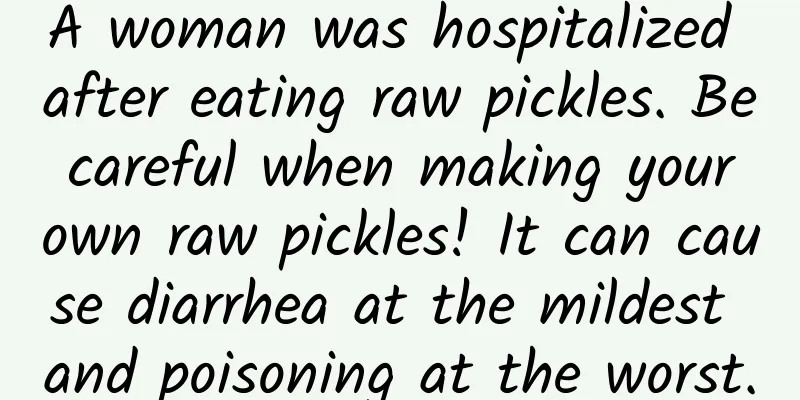A woman was hospitalized after eating raw pickles. Be careful when making your own raw pickles! It can cause diarrhea at the mildest and poisoning at the worst.

|
Recently, there was a trending search #Woman learned to make raw pickled shrimp online and got food poisoning#: A woman in Yantai, Shandong Province, learned to make raw pickled shrimp online. The tutorial required soaking the raw shrimp in white wine, but the woman soaked it in cooking wine. As a result, she felt unwell and weak after eating it, and was admitted to the hospital because of food poisoning. ▲Photo: Screenshot from Weibo The alcohol concentration of cooking wine is much lower than that of white wine. White wine is generally 40VOL%, while cooking wine is generally 10VOL%. Many people think that the woman got food poisoning because she used the wrong wine. In fact, there are still risks even if she used white wine, because white wine may not completely kill parasites and bacteria. Raw pickled food is very popular in coastal areas and has gradually become a popular food on the Internet, but is it safe? In this article, we will talk about raw pickled food. 1. Are raw and pickled foods more nutritious? ▲Photo: Photo Network The most common raw pickled foods are drunken shrimps, drunken crabs, drunken mud snails, etc. Many people believe that raw pickled foods are not cooked at high temperatures, so the nutrients are more completely preserved, and therefore have higher nutritional value than cooked seafood. In fact, raw and pickled food does not mean more nutritious. The main nutrient in seafood such as shrimp and crabs is high-quality protein, which needs to be denatured by heating to be more easily absorbed and utilized by the human body. In addition, raw and pickled foods require the addition of more salt and sugar during the production process to inhibit microbial fermentation, and they also contain higher concentrations of alcohol. Therefore, raw pickled foods are generally high in salt, alcohol, and even sugar. They are not healthy foods and are not very nutritious. 2. Homemade pickled vegetables are unsafe ▲Photo: Photo Network Many people like to make drunken shrimps and crabs by themselves, but compared to purchasing them from regular manufacturers, homemade drunken shrimps and crabs are very unsafe and can easily cause diarrhea or food poisoning after eating them. An experiment compared the bacterial residues in commercially available drunk shrimp and homemade drunk shrimp. The commercially available drunk snails and crabs (bottled products) had a lower bacterial count, with a total bacterial count of only 10 to 40 CFU/g. The homemade drunk shrimp had live bacteria remaining several hours to several days after being drunk, and the remaining bacteria were Vibrio and Gram-positive Bacillus. [1] The comparison of the number of bacteria in traditional drunken shrimp and commercially available drunken shrimp is shown in the figure below (from reference [1]): So to be on the safe side, it is better to heat it thoroughly before eating! 3. Dangers of Homemade Pickled Vegetables The Hong Kong Food Safety Center stated: Raw pickled seafood is a high-risk food. Pickling fish and crabs with wine, vinegar, soy sauce, garlic, chili, etc. cannot kill these harmful microorganisms and parasites. Marinating involves soaking food in a seasoning solution to add flavor, but it does not remove enough moisture from the food to prevent bacterial growth, nor does it kill any parasites. It is essentially no substitute for thorough cooking. [2, 3] The main hazards of raw and pickled foods are parasites, bacteria and viruses. 1. Parasites: Although parasites are small, they can survive for decades, growing from eggs that are invisible to the naked eye to worms that are visible to the naked eye. The smallest parasite is less than 1 mm, while the largest parasite can grow up to 9 meters. Common parasitic diseases include trichinosis, anisakiasis, ascariasis, hepatic trichinosis, and tapeworm disease. Eating pickled or undercooked freshwater crabs, lobsters, and especially our country's drunken crabs, often leads to lung fluke infection. Immature lung flukes wrap themselves in a protective cyst, where the larvae can survive for decades. Freshwater crustaceans may contain Diphyllobothrium latum. After parasitizing the body, the eggs will gradually grow into larvae, penetrate the wall of the small intestine, enter the blood circulation, and finally invade muscle tissue and other cells. ▲Image: The tapeworm’s head has a suction cup-like structure that can attach to the small intestinal wall (Image from reference [4]) Sushi and sashimi that Japanese people like to eat are the main causes of Anisakiasis infection. It often parasitizes in fish such as salmon, mackerel, squid, herring, grouper, flounder, etc. According to statistics from Tokyo, Japan: 1,000 people in Japan are infected with Anisakis every year, most of which are related to home-made sushi and sashimi. ▲Photo: A living Anisakid nematode in a flatfish (Image from reference [4]) 2. Bacteria: Bacteria are highly adaptable and can grow and reproduce as long as the environment is suitable. Bacteria are very small, usually 0.001~0.005 mm, and 200 nanometers to 700 microns in diameter. For example, the most common E. coli in life is only about 2~3 microns long and 1 micron wide. What does this mean? It is only one millionth of a meter in size. E. coli O157:H7 infection can cause gastrointestinal bleeding and even death. ▲Figure: Escherichia coli (Image from reference [4]) ▲Image: An E. coli bacterium moving using flagella (Image from reference [4]) Salmonella is no stranger to everyone. It may be found in sashimi, drunken shrimps and crabs, raw eggs and other foods. Infection can lead to chronic gastroenteritis, sepsis, and even death in severe cases. In addition, there are Vibrio parahaemolyticus, Vibrio cholerae, Clostridium botulinum and so on. Although sugar, salt and alcohol can affect the replication of bacteria and play an inhibitory role, they may not be able to kill them completely. 3. Virus: The size of a virus is generally 20 to 400 nanometers. The virus consists of two parts: one is the DNA or RNA, the carrier of biological information molecules, and the other is the viral protein coating or capsid wrapped outside. There are also a few viral capsids with an envelope outside. Viruses can fuse into cells, introduce DNA or RNA into target cells and accelerate infection. For example, Norovirus is one of the most common foodborne pathogens. Once infected, it can cause gastroenteritis, with symptoms such as nausea, vomiting, diarrhea, and abdominal pain. In 2009, Heston Blumenthal's three-Michelin-star restaurant, The Fat Duck, served oysters and razor clams (raw) contaminated with norovirus, causing more than 40 diners to suffer from food poisoning after eating them. ▲Figure: Norovirus (Image from reference [4]) Therefore, cooking thoroughly is the only effective way to avoid the above unsafe factors. For safety reasons, it is best not to eat raw pickled food. Summarize: Raw pickled food is risky, so be careful when eating it! If you really want to eat it, buy finished products from regular manufacturers. They will be inspected before leaving the factory. They can only be sold on the market after passing the tests for parasites, bacterial residues, etc., which is relatively safe. However, such products are generally high in sugar, salt, and calories, which is not conducive to weight control. Yue~~~~Raw seafood...I really can't eat a single bite... References: [1] Jiang Yunsheng, Dong Jie. Hygienic research on alcoholic food[J]. Chinese Condiments, 2009, 34(02): 103-105+111. [2] Centre for Food Safety, Government of the Hong Kong Special Administrative Region Food Poisoning Caused by Eating Pickled Raw Crabs and Raw Cockles https://www.cfs.gov.hk/sc_chi/multimedia/multimedia_pub/multimedia_pub_fsf_177_01.html [3] Centre for Food Safety, Government of the Hong Kong Special Administrative Region, Undercooked Seafood - A Hotbed of Pathogens and Parasites https://www.cfs.gov.hk/sc_chi/multimedia/multimedia_pub/multimedia_pub_fsf_118_01.html [4] Written by Nathan Myhrvold, Chris Young, and Maxime Billet; Photographed by Ryan Matthew Smith and Nathan Myhrvold; Translated by the Modernist Cuisine Translation Team. Modernist Cuisine: The Art and Science of Cooking, Volume 1: History and Foundations [M]. Beijing: Beijing Fine Arts Photography Publishing House, September 2016. |
>>: Latest! The new member of the "10,000-ton destroyer" has submitted his work!
Recommend
Guardian of the desert salt land: Tamarix, you must have been here for a long time
In the vast Gobi Desert of the northwest, there i...
Toyota and Uber jointly develop autonomous driving. Can they surpass their competitors by investing $500 million?
According to foreign media reports, people famili...
How to recall lost users? Analysis from 3 aspects!
Some people say that whether or not one can succe...
What kind of methodology can continuously create popular marketing products?
For most marketers, screen swiping is something t...
Talking about Snakes in the Year of the Snake | The Year of the Snake is here, dragons and snakes are passed down from generation to generation, let’s take a look at the story of the giant snake!
Warning: This article contains multiple photos of...
Are fruits and vegetables tastier now than they used to be? It’s not your illusion, science proves it
When you look at the rows of brightly colored fru...
Good copywriting comes from user research!
I often hear that there are four stages of learni...
Not only from north to south, but also from east to west, in a circle... "Where do birds go?"
As the northern hemisphere enters winter, a spect...
Pay attention to your child’s height, parents must read this useful information!
《Cotton Swab Medical Science Popularization》 Depa...
The first episode of the Aiti Tribe live class: Set sail in 2017 - Embrace big data
【51CTO.com original article】 1. Big Data Framewor...
A must-read for APP promotion, complete promotion data analysis in 3 steps!
When I was reporting business dynamics to the bos...
Wang Sai [Master Class] Elementary School Chinese Reading Score Improvement Class Advanced
Wang Sai [Master Class] Primary School Chinese Re...
How difficult is it to grasp something you can't feel with your mind?
In the science fiction drama "Love, Death &a...
How to write good copy? Learn these 17 methods!
1. First you need to digest the information about...
4 major live broadcast scripts, just apply them and you will be a hit!
With the popularity of live streaming e-commerce ...









